|
Victorian Cottage Charm
by
Bob Brooke
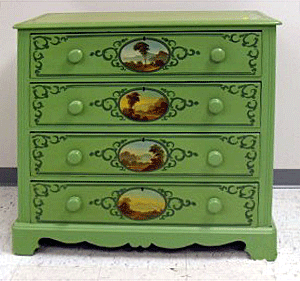 Decorating
magazines picture Victorian rooms filled with grained mahogany, rich
looking walnut, or golden oak furniture. Photographs rarely show painted
pieces. There are several reasons: Painted pieces have not been
reproduced, so the supply is limited. In the 1950s it was fashionable to
buy a painted piece and strip the finish to have a more modern look.
Painted surfaces are difficult to restore, and many old chests and
chairs are worn. This style is known as Cottage Victorian. Most of the
time, Cottage Victorian furniture had simple wooden knobs and handles. Decorating
magazines picture Victorian rooms filled with grained mahogany, rich
looking walnut, or golden oak furniture. Photographs rarely show painted
pieces. There are several reasons: Painted pieces have not been
reproduced, so the supply is limited. In the 1950s it was fashionable to
buy a painted piece and strip the finish to have a more modern look.
Painted surfaces are difficult to restore, and many old chests and
chairs are worn. This style is known as Cottage Victorian. Most of the
time, Cottage Victorian furniture had simple wooden knobs and handles.
Cottage furniture became popular in the United States, particularly in
summer along the East Coast, after the Civil War. Pieces began appearing
in workshops and then homes of the wealthy in places like Martha's
Vineyard, Cape May, and the Berkshires. But the popularity of these
items didnít remain exclusively with the upper class. As the middle
class grew, equally elegant, but relatively reasonably priced versions
began to appear in the homes of the nationís growing work force,
particularly in Pennsylvania and New England.
.gif)
Homeowners purchased Victorian Cottage furniture in mostly bedroom
"suites", sold as coordinating groupings consisting of a double bed, a
washstand, a dresser or vanity with an attached mirror, a small table, a
straight chair and a rocker, and often a wardrobe. Cabinetmakers used
pine or other inexpensive wood, then painted the entire piece with
several layers of paint. The finished sets were colorful and whimsical.
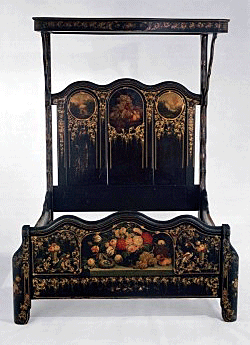 Cottage
Victorian beds have high and lavishly decorated headboards. Finials and
medallions constituted what little carving there was on most pieces.
Most of the decoration took the form of painted flowers, fruit, and
other plants, featuring a large painted bouquet-like medallion in a
central panel on the headboard and a smaller, matching one on the
foot-board. Local cabinetmakers, most of whom didnít have any formal
training, built these pieces from designs in pattern books. And since
they had no formal art training, the decorative elements they applied to
their pieces had a primitive, folk art feel to them. A few featured
highly detailed and beautifully executed scenes of sailing ships or
local wildlife. They painted all the pieces of a furniture suite with
the same motif. The most popular base colors were tan, blues, greens,
and pinks. A few rare ones use the varnished natural wood as the
background onto which the cabinetmaker applied the decorative designs. Cottage
Victorian beds have high and lavishly decorated headboards. Finials and
medallions constituted what little carving there was on most pieces.
Most of the decoration took the form of painted flowers, fruit, and
other plants, featuring a large painted bouquet-like medallion in a
central panel on the headboard and a smaller, matching one on the
foot-board. Local cabinetmakers, most of whom didnít have any formal
training, built these pieces from designs in pattern books. And since
they had no formal art training, the decorative elements they applied to
their pieces had a primitive, folk art feel to them. A few featured
highly detailed and beautifully executed scenes of sailing ships or
local wildlife. They painted all the pieces of a furniture suite with
the same motif. The most popular base colors were tan, blues, greens,
and pinks. A few rare ones use the varnished natural wood as the
background onto which the cabinetmaker applied the decorative designs.
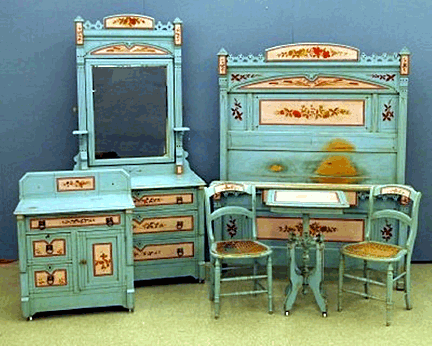 An
artisan then painted it with a base of soft yellow, and highlighted this
coat with green bordering, and rows of flowers, and spandrel fan designs
in the corners, giving it vigor. Although such a piece was commonplace
once, itís rare and valuable today. One of the biggest misconceptions
regarding antiques is that 19th-century homeowners loved the appearance
of natural woods in their furnishings. That preference didnít appear
until the early 20th century. As a result, most painted furniture has
been stripped and finished to the often not very beautiful bare wood by
well-meaning dealers and collectors. Although cabinetmakers refrained
from painting their costly mahogany and walnut pieces, those in small
towns and villages paint-decorated nearly all their birch, maple, oak,
pine, and poplar furnishings to brighten their customersí dark, oil-lamp
lit homes. An
artisan then painted it with a base of soft yellow, and highlighted this
coat with green bordering, and rows of flowers, and spandrel fan designs
in the corners, giving it vigor. Although such a piece was commonplace
once, itís rare and valuable today. One of the biggest misconceptions
regarding antiques is that 19th-century homeowners loved the appearance
of natural woods in their furnishings. That preference didnít appear
until the early 20th century. As a result, most painted furniture has
been stripped and finished to the often not very beautiful bare wood by
well-meaning dealers and collectors. Although cabinetmakers refrained
from painting their costly mahogany and walnut pieces, those in small
towns and villages paint-decorated nearly all their birch, maple, oak,
pine, and poplar furnishings to brighten their customersí dark, oil-lamp
lit homes.
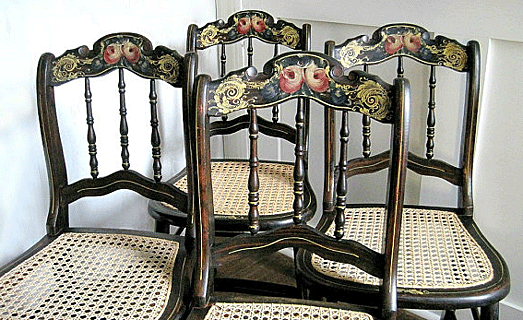
Cabinetmakers fitted drawers and cabinet doors with wooden knobs instead
of metal hardware. Even the boldly colored paint, didnít have the look
of value to it. Those pieces of Victorian Cottage furniture that have
survived intact usually have a crackled surface from age-shrinkage, with
flakes in spots due to dryness. Also, look for signs of wear on edges,
tops, and near the knobs.
To the untrained eye, Victorian Cottage furniture looks as if it should
be sold as junk or stripped to the bare wood. Whatever you do, don't
strip your sideboard. If possible, get an opinion from someone who knows
painted furniture.
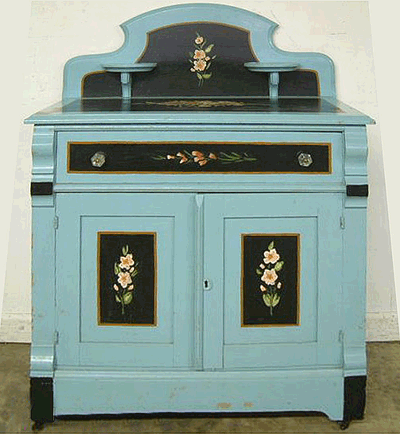 When
purchasing painted Cottage Victorian furniture, look for a bone dry
surface, subtle wear, and age crazing that has shrunk geometrically.
Fortunately, those who fake antiques haven't figured out a way to create
spider-web-like lines with chemicals. Good painted furniture has charm
and an integrity that makes it one of today's best antique investments
since painted pieces havenít been reproduced. . When
purchasing painted Cottage Victorian furniture, look for a bone dry
surface, subtle wear, and age crazing that has shrunk geometrically.
Fortunately, those who fake antiques haven't figured out a way to create
spider-web-like lines with chemicals. Good painted furniture has charm
and an integrity that makes it one of today's best antique investments
since painted pieces havenít been reproduced. .
Pine or other inexpensive wood was used. The entire piece was covered
with paint, usually several layers. Flowers or scenes were painted on
the center of doors, and smaller painted decorations were added as
needed. The finished sets were colorful and whimsical.
You can find a fine painted dresser today for less than $1,000, a bed
for less than $300.
If you own or buy painted furniture, use it carefully. The paint is a
large part of its value. Washing, polishing or waxing might discolor or
remove the paint. See ďCaring for Your Antique Painted Furniture.Ē
<
Back to Antiques Archives
Next Article > |
